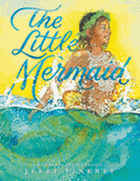
Jerry Pinkney (The Lion and the Mouse) has mastered the art of the picture book rethink, and he comes through again in The Little Mermaid. Somewhere between Hans Christian Andersen's turmoil and Disney's pageantry, Pinkney has found the sweet spot, where one of folklore's most famous deals with the devil is struck in the name of not love but friendship.
Pinkney's Melody, the youngest of the Sea King's four daughters, would rather explore sunken ships than sing in a mermaid choir with her sisters. In one wreck she finds a figurine that "looked a bit like her, but for two cloth sticks where its tail should be"; it fuels her sense of wonder about "the world beyond her home." Melody's sisters remind her that their father forbids them to stray: he fears that the Sea Witch, who has been cast out of the kingdom, will seek revenge on his family.
The king entrusts an old sea turtle to be Melody's minder, and when it surfaces for a gulp of air, Melody tags along. She's beguiled by a girl on the beach with "two sticklike legs" who throws a genial wave her way. After Melody reluctantly returns to her father's kingdom, a sea snake cajoles her: "So sad.... Here you are, stuck undersea... but the Sea Witch can help."
Pinkney's The Little Mermaid is a princeless endeavor; it's the prospect of friendship that inspires Melody to trade her voice for a pair of legs. As he did in Little Red Riding Hood, Pinkney, working in pencil and watercolor, has given a fairy tale's traditionally white cast brown skin, and the rich umber hues round out his jewel-toned underwater color scheme and sun-kissed seaside palette. Readers are lucky: unlike Melody, they needn't choose between the two shimmery, color-drenched worlds. --Nell Beram, freelance writer and YA author

